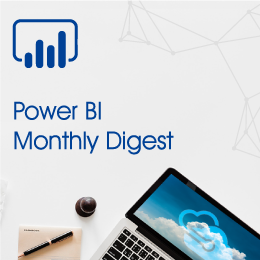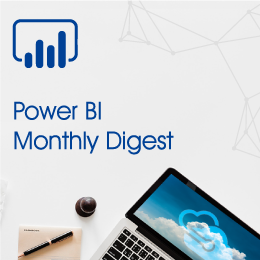

Welcome back to Power BI Monthly Digest for April! There’s quite a long list this month and some things I know you’ve been waiting on, so I think you’ll be excited about those. As always, be sure to check out the video included here for demos on the features I discuss here. So, let’s get to it!
1. Filters – We introduced the new filter experience in a prior video. There are some big additions and changes to filters this month. The main thing is that, as previously stated, Power BI’s goal was to have only one location for filters and now that’s the case. The filter pane that was under the Value section is gone.
The new filter experience (or pane) is right next to the Visualizations pane and you’ll now see a new Add Data Fields here. We can simply drag fields over from the Fields section to this Add Data Fields area. So, if you go over to Dates under Fields and drag over Calendar Year, for example, the same experience that we’re used to presents itself in the filter pane (with some slightly different naming conventions) but we can choose where we want this to be applied, either at the page level, report level or visual level.
You also can format the filter pane and filter cards under the Filter Pane in Visualizations where we can change background colors, text sizes and other options. We can go in and change these manually, but something that many in the community will appreciate, is the previously added theme file option, the filter pane is now included as part of the theme file feature. So, you can standardize this capability to be part of your theme file.
Another cool thing is we can right-click on any filter in the pane and rename it to make it more obvious of the filter that is being leveraged. And each visual in the new filter experience has a little filter icon that when users hover over it, it will give them the filter name you chose, thus making it more apparent.
Something else added is the ability to control whether your users can change those filters. This relates to filter type, so when we expand the filter option, you have that basic filtering (default) option or advanced filtering. But now you have the option to choose if you want your users to be able to change between those types by going into Report setting under Options and Settings and choosing that option.
2. Conditional Formatting – Do you sometimes wish you could make your report visuals dynamic in some way? Well, now you can in Power BI on titles of your report visuals, as well as conditional formatting on web URLs.
Let’s say we’re looking at a product number and we want to configure something that will create a URL for us and that takes us to an external site that has more info about it. Plus, it can be dynamic where every time you change a filter, on changes you select, it changes that URL so you can jump over to a website that may show a list of products or product details.
Because we build this with DAX and we can add calculated measures, there’s a lot you can do here. We show a specific example in our video but keep your mind open to your use cases as there are lots of cool things you can do with this.
Web action was introduced previously where you can click on something and make it launch a website – now you can make it a dynamic website by going to the Format Image section and select URL under Action and create a calculated measure. You then just need to right click the Web URL area and you will see an option for Conditional Formatting, just like everyone is used to.
With this if you were doing a report that included countries and you wanted to be able to link to Google Maps, you could build that so when you click on a specific country in a visual and select the icon you’ve set up with a conditional format, it would go out to Google Maps and right to that specific country you clicked on in the visual. (see our demo)
Just think of all the wild things you can do with this!
3. Query Editor – There have already been components of data profiling added and column distribution elements; they’ve made some enhancements to this so additional column profiling is available. Also new is whenever you do something in the Query Editor, it’s restricted to the first 1,000 rows, but now in column profiling they’ve made it so you can do that column profiling against the entire data set.
The column distribution features are available in preview and you can turn these on under the View menu. At the bottom on the page you’ll see column profiling with new features and statistics about your columns that you can review now. You’ll also see that you can select column profile on the entire data set in the drop down instead of the default of the first 1,000 rows.
It will take a bit longer but it will give you a better understanding about distribution of your data and statistics around your data plus other important info like: what you need to do from a transforming perspective or show you all the blanks and nulls, for instance. We’re still a bit limited visually when in the editor like how we’re creating our business rules and our applied steps, it will still only be in those first 1,000 rows.
Another new thing, great for new users, is when we’re inside the Power Query Editor, we can turn on the formula bar. Previously, we had the capability to hit advanced editor in the home ribbon and you’ll see the IntelliSense, but it was limited to that location. Now, if you go in and write some M right into that formula bar at the top of the editor, it now leverages IntelliSense that’s built right into that formula bar.
4. Drillthrough – This could be the most exciting new feature; a new weapon in our toolset in the digital storytelling realm. Everyone loves drilldowns which gives great capabilities to end users to navigate through visuals. Then drillthroughs were introduced to let us tie pages together within the same report.
Now, we’re excited to present drillthrough across reports! You can now have two people working on separate reports – maybe one is more high-level, less detailed and the other is more fine-grained with detail to the lower tier – we can set up the less detailed report so that when someone right-clicks on something, you have the option to have it present the name of a different more-detailed report (if both reports are in the same workspace).
You do need to set this up ahead of time so the report will have a drillthrough and it will be allowed to go across reports, and you’ll need to set it up from your source report to be able to go across reports as well.
It is a pretty simple process where you can select a field for the target report and drag it into the normal Drillthrough filter. After that you will see a toggle option to turn on Cross-Report. Finally, in the source report, you just need to go into the Report settings and allow it to see other reports inside the same workspace. To get a more detailed look about how this awesome new feature works and how to set it up, check out our demo on the video included here.
5. Key Influencers Visual – They’ve made some changes on this to make it a little easier to work with different types of data. You now have the option when you leverage the Key Influencers to do analysis over a continuous data set, so continuous numeric values. This is done with a toggle box which you can hit within the drop down in the Formatting area.
6. Q&A – Improvements have made it easier for Q&A to work with partial searches, part of a phrase or column name for example, so it will better pick up on those partial name searches to help you out with IntelliSense.
7. General Availability – Here are a few items that went into GA this month:
- Python – Python integration is now generally available so you can do that in production.
- PDF Connector – This was introduced in preview a few months ago and people were excited about – having another source option is always a great thing.
- Workspaces – The new workspace experience is going to be GA. Basically, the interface has been inversed. Before when you hit create workspace, you would be creating a classic workspace and in the upper corner you had a bar to create a new workspace. Now when you hit create workspace, it will be creating a brand new one and if you want to create a classic one, you’ll see that option at the top.
- Heat Map for Map Visual – Within the format options of the standard Map visual you will now find an option that says Heatmap. Simply toggle this option on and the map will change accordingly. There are some associated options you can also tinker with.
That’s it for April; lots of things I’m excited about, and I know many of you are too! To get the full release of what’s new for April, check out Power BI’s website. As always, let us know what you’re excited about or what you’d like to see added to Power BI in the comments section below or if you have any cool use cases of any new feature that we can share.
Devin and I will be back next month with our favorite new features and enhancements for May! Be sure to subscribe to our blog and You Tube channel so you won't miss a thing!
Sign-up now and get instant access
ABOUT THE AUTHOR
Free Community Plan
On-demand learning
Most Recent
private training







-1.png)
Leave a comment